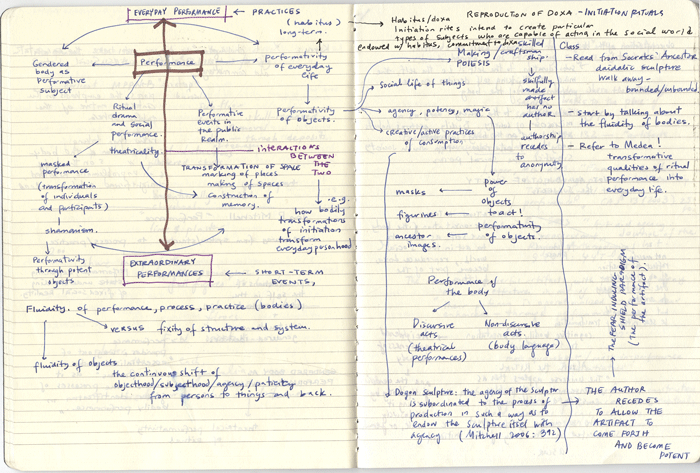Questions, ideas, notes for discussion:
- Jon Mitchell writes about everyday performances and "extraordinary" performances and the interaction between the two, which I found very intriguing, especially when coupled with Bourdieu's concept of habitus. Contrast to early performance theorists who liked to set apart performance from everyday life (Carlson 16). I would like to reflect even more about the daily performances of the embodied subject and the dramatic spectacles in the social sphere. And what happens to individuals, things and spaces in that process (Omur, Sept 28 Thu 3:56 pm).
- I have a working definition of performance: "Discursive and non-discursive dispositional practices and transformative bodily acts of embodied subject(s) (and sometimes even objects/things/artifacts) in the social realm and the everyday, where representations, social significations are unbound and fluid." Quite crazy and obviously needs unpacking. Thoughts? Here another one, compare. (Omur, Sept 28 Thu 11:14 pm).
- This question of the audience is worthwhile to pursue in performance studies, it seems. Is audience necessary for performance and performativity to function? How does the status of the observer/spectator shift when speaking of everyday performances and extra-ordinary performances, public spectacles? Is there an aufience in ritual performance, or childs' play? The sharp seperation of the spectator and the actor in modern theatrical performances clearly do not apply to social drama/ritual action/everyday performance. (Omur, Sept 28 Thu 11:14 pm).
- Well, check this out: "Seeing is believing. Images do not deceive while words can be easily manipulated." (Inomata and Coben 2006: 19). Yeah right (!)... (Omur, Sept 28 Thu 11:40 pm).
- How do spaces gain performativity and potency? How does the relationship between the representations in spaces and the social performances that take place in them operate? Jon Mitchell discusses this quite a bit but only from a social anthropological perspective, and not so much from an architectural/spatial one. I hope we can bring this up especially when discussing our Neolithic sites. Where I would like to get to eventually is probably close to what David Turnbull calls "spatialized narratives" where space is performed through bodily involvement, and a collective corpus of knowledge/social memory is constructed again through a performative relationship among embodied subjects, material objects and social spaces. (Omur, Sept 29 Fri 0:10 am)
- Very impressed with this quote from Bourdieu (appeared twice in the readings so far): "The body believes in what it plays at: it weeps if it mimes grief. It does not represent what it performs, it does not memorise the past, it enacts the past, bringing it to life" (P. Bourdieu, Logic of Practice. Trans. R. Nice. Stanford University Press, 1991: 72-73, cited in Mitchell 2006: 386 and Turnbull 2002: 131. Unpacking? (Omur, Sept 29 Fri very late am - I need to go to bed)
Johns Hopkins Guide to Literary Theory and Criticism's 2nd edition entry "Performance Studies" by Jon McKenzie. I tried to access this guide through Brown but couldn't locate. You can download the entry below. It is very very helpful:
 performance_studies-JHGLTC.htm
performance_studies-JHGLTC.htm
Some interesting performance artists:

Cindy Sherman. Film-still-portrait of herself as the performing subject/actor as in a Hollywood film setting.
(The movie doesn't exist).

Better image:  Performance.jpg
Performance.jpg
